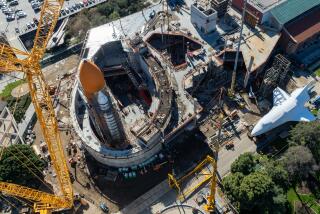Gouge in shuttle is deep, may need in-space repair
- Share via
NASA said Sunday that tile damage to the shuttle Endeavour was as deep as feared, adding that the space agency would decide in the next 48 hours whether to send an astronaut out to fix it.
Deputy shuttle program manager John Shannon said the damage on the underbelly of Endeavour cut through two 1.12-inch-thick silica tiles. The only thing there to shield the shuttle’s thin aluminum skin from the 2,300-degree heat of reentry is felt that’s about a tenth of an inch thick.
The felt is designed to keep the tiles from moving with the surface of the shuttle.
It would not provide much heat protection, but if the heating is evenly spread across the underbody, the problem might not be critical.
“We would rather not deal with this, but we have prepared for it,” Shannon said during a briefing at Johnson Space Center in Houston. “I have a lot of confidence that if a repair is required, we could execute it.”
Endeavour carries three insulating-tile repair kits: a paintlike wash, a screw-on protective plate and a puttylike substance known as “the goo.”
The kits have not been tried in a real crisis, and previous shuttle crews have expressed reservations about trusting their lives to space repairs.
Shannon tried to downplay fears that the shuttle and its crew were in danger, emphasizing that NASA engineers might determine that the damage isn’t worth fixing. He said previous shuttle flights had safely returned to Earth with tiles damaged in similar ways.
Close-up views of the damaged area were obtained Sunday using a camera and laser on a 50-foot boom. The crew of Endeavour maneuvered the boom remotely, using the International Space Station’s 50-foot arm to manipulate the boom and its sensors.
Five damage sites on the underbelly were scrutinized. Most were minor and required no further study, Shannon said.
The most damaged area has a worrisome flattened area, which could concentrate heat flow, Shannon said.
“This is not a long scrape, it’s a localized scoop,” Shannon said. Heat building up in one area is the greatest danger to the shuttle because the heat could eventually cut into the body of the spacecraft.
On the positive side, the damaged area is underlaid by an internal body strut that will provide extra support during reentry. Also, there are no electronics or other sensitive equipment in the area.
Film retrieved from the two solid rocket boosters that helped propel Endeavour to space revealed that the cause of the damage was a chunk of insulating foam that sloughed off the shuttle’s giant external tank near a fuel feed line. The incident occurred 58 seconds after liftoff Wednesday from Cape Canaveral, Fla.
The foam hit a strut on the fuel tank, then bounced into the underside of the shuttle, near the right main landing-gear door.
The same type of damage has been seen on several recent shuttle flights. Shannon said NASA would undertake an extensive review after Endeavour returned to find out what was causing the foam loss near the feed line.
It’s too early to know whether future shuttle flights will be halted until the problem is resolved, he said.
“We’re 24 hours into the realization that this has happened on several flights,” Shannon said.
Engineers suspect that ice forming under the insulating foam on the fuel tank’s feed line is causing the foam to break away during launch.
It’s particularly difficult to evenly apply foam in cramped areas around feed lines and brackets.
NASA added new cameras to the shuttle after the loss of Columbia in 2003. Before then, officials did not know that the spacecraft was sustaining damage so consistently during launch.
Problems with foam and ice falling off the external tank and hitting the shuttles during launch are a primary reason that NASA has decided to mothball the shuttle and replace it with a new design that places the crew capsule atop a rocket, like the Apollo spacecraft of the 1960s and 1970s.
NASA officials on Sunday decided to extend Endeavour’s mission three days -- to 14 -- after mission managers decided the craft had enough power to spend extra time working on the space station.
Today, the crew is scheduled to replace a faulty gyroscope, one of four that keep the station properly aligned in space. They have already attached a new station truss segment, a portion of the station’s backbone.
More to Read
Sign up for Essential California
The most important California stories and recommendations in your inbox every morning.
You may occasionally receive promotional content from the Los Angeles Times.













